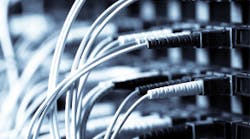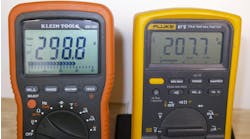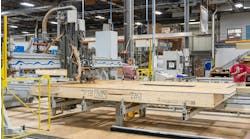From data and voice to security and videoconferencing, many of today's IT infrastructure services rely on fiber optics to transmit information faster, farther, and in greater amounts than ever before. The reasons for fiber's popularity are clear: Its bandwidth helps future-proof networks for increased capacity needs; its immunity to electrical interference makes it a great option for security and data-sensitive networks; and its reputation for reliability means worry-free maintenance.
This spells good news for electrical contractors looking to grow their business by capitalizing on new networking opportunities. However, as with any new technology, selecting the right products and determining costs can be daunting.
A birds-eye approach
A solid assessment goes a long way toward perfecting the build-out of a new or existing fiber-optic solution. Installers must evaluate the current needs of the network and then look down the road to how it will be used in the future.
Selecting the right type of fiber depends on the application. The cable used to upgrade an existing backbone, for example, may be different from the cable used to connect directly to surveillance cameras. Similarly, connections to multiple service applications, such as physical security, environmental control, and data, affect the fiber strand count.
After looking at the immediate applications, installers should also consider upcoming applications and capacity needs. Future bandwidth requirements, transmission distances, applications, and network architecture influence fiber selection just as much as current needs. Therefore, a careful assessment of potential network usage will help avoid the costs of preventable upgrades.
Multimode vs. single-mode
Multimode is typically recommended for applications involving shorter distances. Connections within the data center, for example, are ideal for this type of fiber, because the distance between devices is relativity short. Multimode fiber transmits Gigabit Ethernet up to 550 m. Although it can't go as far as its single-mode sibling, its lower-cost interface makes it an economical solution.
Multimode cabling is available in several performance levels to support a variety of distances: OM1 applies to a large portion of the installed legacy systems; OM2 supports Gigabit Ethernet up to 550 m; and OM3 is laser-optimized to support 10G Ethernet up to 300 m. With a faster, higher-bandwidth OM4 standard on the horizon, 10G applications may also be supported up to 550 m. Table 1 (click here to see Table 1) provides a detailed comparison of various fiber performance levels.
Although multimode distance capability is growing, it can't compete with the distances single-mode fiber can accommodate. In addition to its far reach, single-mode fiber offers virtually unlimited bandwidth, making it an excellent solution for campus and metropolitan networks. The power of single-mode fiber comes from the high-powered lasers that transmit data at greater distances than the light used with multimode fiber. While single-mode fiber costs about the same as multimode, it's often reserved for backbone connections that don't have the higher-cost network interfaces associated with single-mode fiber.
When talking about single-mode fiber, two terms are frequently cited. OS1 is the traditional single-mode fiber used by telecommunications companies to support communications services. OS2 can accommodate greater bandwidths at greater distances — and is expected to make 40G and 100G networks a reality in the near future.
Because major network overhauls often require both types of cable, some manufacturers have developed a hybrid cable that contains multimode and single-mode fibers under one jacket. This solution saves installation, takes up less pathway space, and can be customized for a variety of applications.
Making the connection
Connectors keep the information flowing from cable to cable or cable to device. Loss occurs at the connectors when light passes information between the cables, or to the network device. Currently, networking standards recommend several fiber-optic connectors. Traditionally, networks have relied on ST connectors. Over time, however, they have moved to adopt SC connectors, which provide slightly better performance against loss, more efficient installation, and easier maintenance.
As data center managers place increasing importance on saving space, users are embracing the LC connector. These connectors offer even lower loss in a smaller form factor and provide higher performance and greater fiber density.
Today, contractors have choices when installing connectors. Traditional epoxy connectors require installers to cleave and feed the fiber strand into the connector, secure it with an epoxy adhesive, and then field polish the connector's tip. This labor-intensive process has led many contractors to adopt factory-tested, pre-terminated connectors. Here, the fiber strand is cleaved and fed into the connector. The connector then creates a connection with the pre-polished tip and crimps the fiber into position. These connectors are quick to terminate and provide consistent performance.
Network performance
Once the cable type and connectors are selected, technicians are in position to begin evaluating the interface options that drive network performance.
Many of today's devices, such as security cameras, transmit data across Gigabit and 10G Ethernet protocols that support a variety of optical interfaces. However, knowing which interface to use for the application depends on the fiber type, cable distance, and speed of the connection. Table 2 (click here to see Table 2) provides an overview of the most common types of interfaces.
For most network devices, installers can rely on modular Gigabit fiber-optic interfaces, called gigabit interface converters (GBICs). These flexible interfaces come in several form factors, including XENPAK and SFP+, and can accommodate a variety of device applications.
The cost of these modular interfaces can range from between $250 to $1,000 (or more), although Gigabit interfaces cost less than 10G interfaces, and multimode interfaces cost less than single-mode, which is the most expensive. Once cable type is established, technicians can select the interface that meets the application needs at the best cost.
When selecting interfaces, contractors need to be aware of their light sources. Light-emitting diodes (LEDs) work only with multimode fiber and operate at the 850-nm window; laser works only with single-mode fiber and operates at the 1,550-nm window; and vertical-cavity surface-emitting laser (VCSEL) works with both types of fiber and operates at the 1,310-nm window.
Fiber protection
A reliable network is one with the appropriate safeguards in place. Just as cable type, connectors, and interfaces are determined by applications, fiber protection is application-specific as well. For example, the pathway space can be a concern when upgrading the cabling in an existing facility. Traditionally, installers have relied on innerduct to protect the fiber. However, this can be a time-consuming process that often requires the technician to install the innerduct through the pathway and then pull the fiber through the innerduct.
Today, contractors can install fiber with an armored metal jacket that not only protects the cable, but also saves space by allowing more cables to be installed within a single conduit or pathway. Using armored fiber reduces pathway uses, requires fewer installation steps, and saves labor costs.
Environmental conditions are other factors that must be evaluated when selecting protective fiber jackets. For example, PVC cable jackets are suitable for indoor environments; however, cabling that runs through a plenum space will need to conform to fire codes. In these cases, plenum cable jackets are required. Similarly, OSP jackets are used for outdoor applications, but when the cable needs to enter a building beyond 50 ft, installers must transition to an indoor-rated cable in conformance with fire codes. One way to eliminate this transition point is to use a cable jacket with an indoor/outdoor rating. These indoor/outdoor cables are available with either a PVC or plenum rating.
While the answers to most protection decisions are obvious, complications can arise when installers work with higher-speed technologies. For example, Gigabit and 10G have strict link-loss budgets that require technicians to avoid indoor-to-outdoor transition points. In this case, it may be wise for a contractor to use a hybrid cable that can accommodate indoor-outdoor applications.
A future with fiber
The possibilities for fiber-optic cabling combinations are endless. Knowing the applications and desired capabilities is the logical first step to determining the necessary supplies and costs of building that “perfect” network.
The future of fiber holds true the possibility that information will one day travel at speeds only understandable today through the laws of physics. With its higher bandwidths, flexibility, and security, fiber offers a promising solution to current networking challenges. As technology advances with lower-cost fiber-optic interfaces, opportunities will continue to expand for contractors and IT installers.
Ost is a network systems specialist with Graybar, Rancho Cordova, Calif. He can be reached at [email protected].



